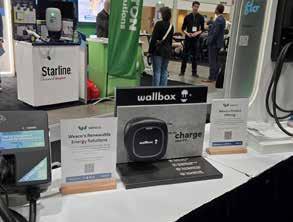POWERING THE EV
EXAMINING THE 12-VOLT BATTERY’S IMPORTANCE
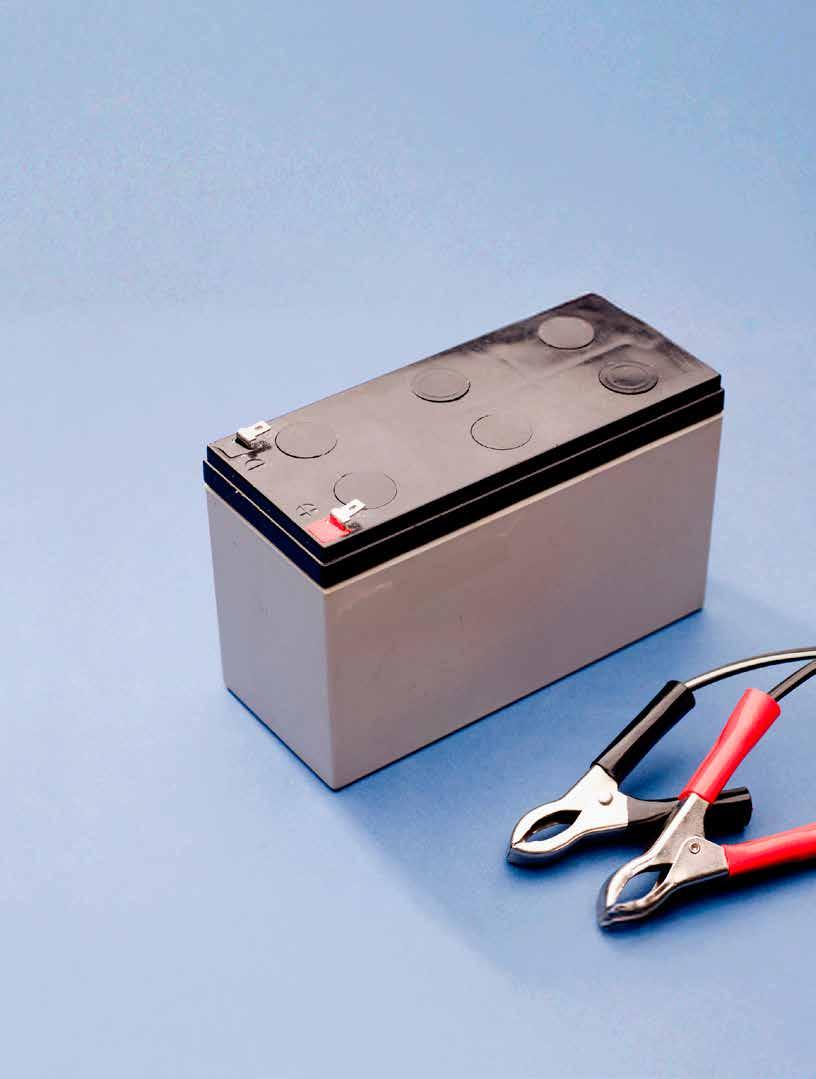
PRESSING BUSINESS NEEDS FOR SHOPS +
GAUGING THE PACE OF INNOVATION

EXAMINING THE 12-VOLT BATTERY’S IMPORTANCE

PRESSING BUSINESS NEEDS FOR SHOPS +
GAUGING THE PACE OF INNOVATION
Scan the QR code to catch up!




A ROADMAP FOR OUR AFTERMARKET FUTURE, WITH DONOVAN RINGO

POSITIONING YOUR SHOP FOR SALE, WITH SUNIL PATEL

GLOBAL UNCERTAINTY AND RESILIENCE, WITH BILL HANVEY

THE FUTURE OF AUTOMOTIVE TRAINING, WITH J.F. CHAMPAGNE










Publisher | Peter Bulmer (585) 653-6768 peter@turnkey.media
Managing Editor | Adam Malik (647) 988-3800 adam@turnkey.media
Contributing Writers | David Mayers, Derek Suen
Creative Director | Samantha Jackson
Video / Audio Engineer | Ashley Mikalauskas, Nicholas Paddison
Sales | Peter Bulmer, (585) 653-6768 peter@turnkey.media
Delon Rashid, (416) 459-0063 delon@turnkey.media
Production and Circulation | Delon Rashid, (416) 459-0063 delon@turnkey.media
EV World magazine is published by Turnkey Media Solutions Inc. All rights reserved. Printed in Canada. The contents of this publication may not be reproduced or transmitted in any form, either in part or full, including photocopying and recording, without the written consent of the copyright owner. Nor may any part of this publication be stored in a retrieval system of any nature without prior consent.
Canada Post Canadian Publications Mail Sales Product Agreement No. 43734062
“Return Postage Guaranteed” Send change of address notices, undeliverable copies and subscription orders to: Circulation Dept., CARS magazine, 48 Lumsden Crescent, Whitby, ON, L1R 1G5
CARS magazine (ISSN# 2368-9129) is published six times per year by Turnkey Media Solutions Inc., 48 Lumsden Crescent, Whitby, ON, L1R 1G5
From time to time we make our subscription list available to select companies and organizations whose product or service may interest you. If you do not wish your contact information to be made available, please contact us.
For some time, the automotive aftermarket has viewed electric vehicles with a mix of curiosity and caution. Would they wipe out much of the traditional service work? Would independent garages be left behind as automakers locked down diagnostics and repairs?
We’re starting to get a clearer picture. After fears that there would be too little work in EVs to support a sustainable aftermarket, we’re seeing just how much more work there is for this industry. It’s a transformation of the job pros do.
The shift to EVs doesn’t mean the end of maintenance — it just means a different kind. Brakes still wear and corrode. Tires still need replacing. Suspension components take even more of a beating. And yes, EVs still break down. According to RepairPal, a Tesla faced US$832 in annual repair costs while the average ICE vehicle sat at US$652 in 2023.
The difference now is in how the industry prepares to service them.
David Mayers’ piece in EV World goes even deeper, highlighting one of the most pressing — and profitable — areas of EV service: High-voltage battery repair. With more than 250,000 EVs now on Canadian roads and many of them aging out of warranty, battery diagnostics, repairs and replacements are becoming a critical need.
And right now, there’s a shortage of shops ready to meet that demand. For those in regions with high penetration, this is where the opportunities lie.
Independent garages have always thrived by being nimble, responsive and community-focused. In rural and northern areas where dealership access is limited, local shops could become essential lifelines for EV owners. And in urban centres, where EV adoption is growing fast, the ability to offer battery repairs — not just replacements — could be a game-changer.
The economics are compelling. A full battery replacement can cost in the range of $20,000. But a shop can diagnose and replace a few faulty modules — as many OEs designed their vehicles to allow, rather than changing out the entire battery — for a fraction of that cost.
This not only saves the customer money, but it also builds trust and loyalty. It further opens the door to new revenue streams, from pre-sale battery inspections to warrantybacked repairs and even mobile service.
This isn’t an overnight shift. Servicing EVs — especially their battery systems — requires training, safety protocols and investment in the right tools. But as Mayers points out, the return on that investment can be significant. And with colleges, training programs and suppliers stepping up, the support is there for shops that want to make the leap.
What’s needed now is a mindset shift from threat to evolution of the aftermarket, just as has been seen throughout the recent decades. The fundamentals of good service — knowledge, trust, quality work — haven’t changed. The vehicles have.
President & Managing Partner | Delon Rashid Head of Sales & Managing Partner | Peter Bulmer
Corporate Office
48 Lumsden Crescent, Whitby, ON, L1R 1G5

The aftermarket has always been about solving problems and keeping Canadians on the road. That mission hasn’t changed. What’s changing is the opportunity.
Adam Malik Managing Editor, EV World

We want to hear from you about anything you read in EV World magazine. Send your email to adam@turnkey.media
I don’t think a wide range of affordable EVs is the answer. Consumers would much prefer a smaller selection of serviceable vehicles with the promise of affordable longevity than a cheap throwaway car. A long lasting serviceable product is better for consumers’ financial well-being, better for the environment and global warming, and also better for my aftermarket business. Win,Win, Win.
Rob Nurse, Bob Nurse Motors
The government had no reason to be giving away tax payer money to people who decided to purchase electric vehicles in the first place. The manufacturers should be the ones offering the rebates. This was only adding to our deficit.
Bob Ward, The Auto Guys
I have a hard time feeling bad for the business’s that made investments in this boondoggle. It has been clear from the onset that these mandates were never going to be possible, but they took the carrot of government programs. Moral of the story, never trust or do business with the government. These people knew better and should have spoken up, instead of leaving others to shoulder the load of looking like knuckle draggers as we try and explain what a farce the EV industry is.
Geoff Walton, Grant Street Garage
Maybe if the greedy government and manufactures legislated and built longer lasting, more affordable serviceable vehicles, consumers would be more apt to consume your commodity. But instead you’re forcing a throwaway product onto intelligent consumers, which the average person does not want. Sorry for your loss, move on to the next idea. We need to transform our economies from a throwaway manufacturing world to a more sustainable servicing world.
Rob Nurse, Bob Nurse Motors
Breaking up H2O into hydrogen and oxygen is a simple process through electrolysis, and thousands of DIY projects are
experimenting with that process. So, with this high interest, a stable solution will be found. The only real roadblocks are the business and political politics, along with the ‘almighty dollar’, that want to determine our future. The K.I.S.S. principle is outside their vocabulary.
Bob Pfaff, Automotive Service Business Network
No thanks. This would be no different than the government siphoning gas from your ICE vehicle in an “emergency” while you’re sleeping. Who in their right mind would sign up for that? If they want to suck the power out of a government-owned bus, go ahead. But a privately owned vehicle? How Orwellian can you get?
Mike Schritt, Davis GMC Buick
Finally, a bit of a common sense report on the status of these bound to fail mandates. Now, if we can start a conversation about how EV’s simply will never be practical to a large geographic portion of Canada, my faith in the brain function of my fellow humans may begin to rebound a little.
Geoff Walton, Grant Street Garage
First of all, there is no such thing as zero-emission vehicles. Not only do you need both zero-emission manufacturing and power industries before building such a vehicle, but plug-in hybrid vehicles (PHEVs) will be considered acceptable for sale in our government’s 2035 legislation. PHEVs are equipped with combustion engines which will require fueling stations. Therefore, their zero-emission mandate is fraud. What consumer in their right mind would take on the expense and inconvenience of these electric vehicles when they have the alternative of driving a plug-in hybrid? My prediction is full-electric vehicles will become extinct as fast as they will appear.
Rob Nurse, Bob Nurse Motors

ELECTRIC VEHICLE DRIVERS in Canada feel more in tune about maintaining their cars — and many will head straight to the dealership when something needs fixing.
New research by the Automotive Industries Association of Canada to better understand how EV drivers approach maintenance and repair broke down behaviours, attitudes and preferences among EV, hybrid and non-EV owners.
Of note, EV owners drive more than their ICE vehicle peers — 20,564 km per year compared to 18,431 for non-EVs. Hybrid drivers reported 18,700 km on the odometer every year.
When it comes to maintenance, EV owners are more likely to say they stay on top of everything (69 per cent) compared to hybrid (62 per cent) and non-EV owners (60 per cent). They’re also more likely to describe maintenance as “very easy” — with 94 per cent saying so, versus 60 per cent of non-EV owners.
But despite this confidence, many EV owners still prefer dealerships with 54 per cent saying they always go to there for service, compared to 49 per cent of non-EV owners. Only 8 per cent of EV drivers said they never go to a dealership.
Loyalty may lie in perceptions around technical expertise. Nearly three-quarters of EV owners (73 per cent) believe dealership technicians are better trained than those at an independent ASP. And 41 per cent worry that taking their EV to an ASP could void their warranty.
However, there appears to be room for the aftermarket to grow.
Three in five EV owners (59 per cent) said ASPs offer better value for money than dealerships. And awareness of local ASPs that service EVs remains low — just 31 per cent of EV owners who always go to dealerships knew of one nearby.
THE NUMBER OF CANADIANS interested in fully electric vehicles remained steady year-over-year but there are still many hurdles in the way, a new report highlighted.
The J.D. Power 2025 Canada Electric Vehicle Consideration Study noted the challenges facing Canada’s EV market. While technological advancements and environmental imperatives push towards electrification, consumer hesitation remains a significant hurdle, it found.
J.D. Ney, director of J.D. Power’s Canadian automotive practice, hosted a webinar to discuss the results. He said that the 2025 results were the first time interest hadn’t dramatically declined year-overyear. However, the Canadian market continues to lag significantly behind its American counterpart.
“About one in 10 new vehicle shoppers in Canada tell us they’re very likely to consider an EV,” Ney explained. “That number, for context, in the U.S. is 24 per cent — so more than double that.”
The national net consideration rate stands at 28 per cent, compared to nearly 60 per cent in the United States.
Ney noted that the reasons for EV rejection remain consistent, with three primary barriers continuing to be range anxiety, purchase price and perceived lack of public charging infrastructure. Seven in 10 (71 per cent) respondents cited concerns about driving distance on a single charge, while nearly 60 per cent pointed to purchase price as a significant deterrent.
The elimination of the federal EV rebate has further complicated the landscape. Two in five (42 per cent) of potential EV shoppers indicated that the removal of the incentive negatively impacted their purchasing considerations.
Ney also explored how personal experience can shift EV perceptions. He explained that a significant portion of Canadians have never even sat in an electric vehicle, and this lack of direct experience correlates strongly with low consideration rates.
“Not surprisingly, if you’re in the group who has never experienced anything to do with an EV, your consideration rates are quite low,” Ney said, adding that consideration rates climb substantially as people progress from having no experience to actually driving or owning an EV.




COLLISION CLAIMS FOR repairable BEVs increased, hitting 4.48 per cent in Canada, according to Mitchell.
The auto technology company’s latest Plugged-In: EV Collision Insights noted that BEVs continue to see the highest average repair costs — $7,026 in Canada — though that figure dropped 7 per cent from the previous quarter. British Columbia and Quebec led the country — and all of North America — in repairable BEV collision claims, with both provinces reporting BEVs as eight per cent of total claims.
For PHEVs, the average repair costs came in at $6,253, down four per cent, and $5,972 for mild hybrids, down six per cent. ICE vehicle repair costs dropped eight per cent to $5,345.
Tesla’s Model 3 (26.16 per cent) and Model Y (24.09 per cent) led Canada in model claims frequency with Hyundai Ioniq 5 (5.25 per cent) rounding out the top three.
New U.S. tariffs are threatening BEV adoption and could disrupt pricing strategies and supply chains, the report added.
It observed that BEV manufacturers face higher import taxes compared to those producing internal combustion engine vehicles, putting them at a disadvantage in the market.
“Tariffs are reshaping the automotive landscape,” said Ryan Mandell, Mitchell’s director of claims performance. “Their impact is especially pronounced for BEV manufacturers, and insurers will need to work closely with repair partners to navigate these changes.”
ELECTRIC VEHICLE OWNERS are still mostly happy with their rides. But study shows that satisfaction is slipping, especially among older drivers and non-Tesla owners.
The second annual EV Ownership Lifestyle Study from CDK Global noted that while enthusiasm for electric vehicles remains strong, some of the shine is starting to wear off.
It found that the vast majority (82 per cent) of EV owners say they’ll
buy another electric vehicle. But that number drops sharply among baby boomers, with only 55 per cent saying they’d go electric again. Additionally, nearly one in three boomers said they plan to return to a gas-only household.
Despite the generational divide, the overall mood is still upbeat. Most owners (86 per cent) are happy with their purchase, and 70 per cent say their EV is the best car they’ve ever owned. But the study also highlights growing concerns around charging, service and coldweather performance.
While home charging remains a key benefit, fewer owners are installing Level 2 chargers — down to 63 per cent from 76 per cent last year. And nearly half of respondents said the installation process was a hassle.
Public charging isn’t much better: 55 per cent of non-Tesla owners reported issues on long trips, from broken plugs to full stations.
Service delays are also on the rise. Only 28 per cent of owners were able to get a same-day appointment, down from 40 per cent last year. And while most repairs were covered under warranty or recall, nearly a third of non-Tesla owners needed four or more visits to resolve their issues.
Range anxiety is still a factor, especially in colder climates. Nearly one-third of all owners said their EV’s range drops in extreme cold, and that number jumps to 48 per cent in cold-weather states.
Even with the bumps in the road, the majority of owners are sticking with electric. Two-thirds say their EV is the best car they’ve ever driven, and 73 per cent have recommended EVs to friends or family.
THE COST OF INSTALLING an electric vehicle charger is keeping many Canadians from purchasing EVs, especially as government grants for installation came to an end.
According to new data from Homestars.com, 55 per cent of Canadian residents believe the government needs to offer more grants and subsidies towards the cost of charger installation.
Support for these grants varies by age group, with 60 per cent of 18-34 year olds and 62 per cent of 35-54 year olds in favour, compared to only 46 per cent of those over 55. Geographically, Quebec shows the strongest support, with 56 per cent agreeing that the government should do more, followed by British Columbia and Ontario (both 55 per cent) and Alberta (51 per cent).
ELECTRIC VEHICLES WERE put to the test by the Canadian Automobile Association to see how they perform during winter months — with up to almost two-fifths of range being lost.
Vehicles representing more than two-thirds of Canadian EV sales were driven from Ottawa to Mont Tremblant, Quebec, in subzero temperatures. The CAA EV Winter Test measured how many kilometres EVs drove before their batteries died and how long it took to get a reasonable recharge.
The test was done in response to one of the top concerns Canadians have when it comes to EVs, said Ian Jack, vice-president of public affairs at CAA National.
“We measured the effective range of electric vehicles in cold weather and how quickly they charge,” he explained. “These insights are critical for both current EV owners and those considering making the switch.”
These tests showed the difference winter makes. Across the board, the vehicles drove 14 to 39 per cent less than their official range. Two vehicles in particular performed well in the cold, the Chevrolet Silverado EV and the Polestar 2, both driving just 14 per cent less than their posted range.
CAA found the cold weather affected EVs very differently, with some doing better than expected while others did not.
“The vast difference in results highlight the importance of truth in advertising when it comes to EV range, and of comparing numbers if winter performance matters to you,” Jack said.
In Canada, only a single average is published, so consumers don’t have a picture of an EV’s range in winter, he added.
“CAA would like to see a made-in-Canada standardized labelling system for EVs that includes winter driving performance rather than just a single average,” Jack said.
More than two-thirds of Canadians in a recent poll told CAA that the drop in range during winter is a top barrier to buying an EV. Among Canadian EV owners, more than 65 per cent say they have experienced lower battery range in extreme cold weather. Officially posted Canadian EV ranges are based on overall, year-round numbers.
The test featured 14 EVs, including seven out of ten of the top sellers in Canada. Models came from sport, luxury, SUV, sedan and truck categories to capture a diverse range of vehicle types.
Temperatures during the drive varied between minus-7 and minus-15 degrees Celsius to represent a typical Canadian winter. Each vehicle was driven until the battery ran completely out of power to determine range in winter conditions. The results were compared to the estimated driving range published by Natural Resources Canada (NRCan).
CAA also tested charging speeds, a critical factor for longer trips in an EV. In CAA’s recent survey of EV owners, four in ten EV drivers said significantly slower charging in extreme cold weather is a problem. More than half (53 per cent) of EV drivers still prefer to take their gas vehicle on long trips in extremely cold weather.
Each vehicle in CAA’s test was connected to a DC fast-charger. The test measured how many kilometres of range were added in a 15-minute session. On average, EVs managed to add around 100 kilometres of range, which amounted to 28 per cent of battery charge.
The Tesla Model 3 charged the fastest, adding over 200 kilometres in just 15 minutes. CAA found significant variations in how much charge an EV could gain in 15 minutes, highlighting the importance
of considering charging rates for those who frequently drive long distances.
CAA included a few tips for drivers on ways to maximize EV performance in cold weather: Precondition the EV by warming the cabin while it is plugged in before starting the drive, clear snow and ice from the vehicle to reduce weight and aerodynamic drag, use heated seats instead of cabin heaters to conserve battery power, and park indoors or on the sunny side of the street to keep the battery warmer.

THERMAL RUNAWAY — THE CHAIN reaction that can lead to EV battery fires — remains a rare but serious risk. And while EVs are statistically less likely to catch fire than gas-powered vehicles, the consequences when they do can be severe. That’s why researchers and manufacturers are investing heavily in fire protection materials and safer battery designs.
A new report from IDTechEx, Fire Protection Materials for EV Batteries 2025–2035, outlined the latest strategies to reduce fire risk in electric vehicles. The report highlighted how evolving battery chemistries and materials are shaping the next generation of EV safety.
It explained that battery fires can be triggered by manufacturing defects, wiring faults, crashes or even while the vehicle is parked or charging. Lithium-ion batteries, the most common type in EVs, carry a small but real risk of thermal runaway — a rapid increase in temperature that can lead to fire or explosion.
But there are materials that can make a difference when it comes to combating battery fires. manufacturers are turning to advanced materials like aerogels, ceramics and mica. Aerogels are gaining traction for their low thermal conductivity, helping to prevent heat from spreading between battery cells. Mica, while denser, is cheap and easy to apply in thin sheets, offering strong electrical insulation.
Solid-state batteries are also showing promise. These use a solid electrolyte instead of a flammable liquid, making them more stable and less prone to overheating. Sodium-ion batteries, another alternative,
have lower heat release rates and have passed nail penetration tests without igniting.
Beyond materials, battery pack design is evolving to give passengers more time to escape in the rare event of a fire. China currently leads the way with regulations requiring a five-minute warning before thermal runaway becomes dangerous — a rule that will tighten to a two-hour no-fire window by mid-2026. Other countries are expected to follow, though likely with less aggressive timelines.

A NEW REPORT FROM Volvo Car Canada reveals that younger Canadians, particularly Gen Z and Millennials, are increasingly drawn to plug-in hybrid electric vehicles (PHEVs) due to a balance of affordability, environmental concerns and flexibility.
The study highlights a growing trend towards greener transportation options, with nearly 14 per cent of vehicle owners already driving some form of electric or hybrid car.
Among younger generations, 51 per cent of Gen Z and 54 per cent of Millennials are likely to choose a PHEV for their next vehicle. Key motivators include the financial benefits, such as reduced fuel costs and the environmental advantages, with 64 per cent of respondents prioritizing sustainability. PHEVs offer the benefit of electric power for short trips while maintaining a gas engine for longer distances, appealing to drivers seeking flexibility.
As gas prices remain high, 75 per cent of Canadians considering a PHEV believe it will help lower fuel expenses. The study also reveals that younger buyers are less inclined to negotiate prices, with 49 per cent of Gen Z and Millennials preferring a fixed price compared to 44 per cent of Boomers.
With the rising interest in PHEVs, the automotive market is increasingly shaped by the preferences of younger, environmentally conscious Canadians seeking to balance their budget and sustainability goals.

THE FUTURE OF FUEL CELL electric vehicles remains uncertain as the automotive industry continues to evolve, according to a study. While battery electric vehicles (BEVs) have seen significant growth in model availability, sales and charging infrastructure, FCEVs have struggled to keep pace. According to the report by IDTechEx, 2024 marked the second consecutive year of declining sales for FCEV passenger cars, with commercial vehicles also lagging behind BEVs.
Despite the promising properties of FCEVs, such as quicker refuelling times, longer range and higher payload capacity, they have not gained the same traction as BEVs. Rapid advancements in DC charging technology have allowed BEVs to charge hundreds of kilometres in range in reduced time, and IDTechEx forecasted that battery costs will continue to decrease while energy density increases. This will result in longer-range, lower-cost BEVs, further challenging the market position of FCEVs.
In 2024, about 5,000 fuel-cell passenger cars were sold globally, a small fraction of the 11 million BEV passenger cars sold in the same year.
In California, the cost of operating a Toyota Mirai was found to be more than eight times higher per mile compared to a Tesla Model 3 and about three times higher than an internal combustion engine car. Hydrogen prices at the pump soared to as high as $36 per kilogram at some stations, a 120 per cent increase from the average price in 2022. This price volatility and uncertainty have deterred potential customers.
For commercial vehicles, the potential for FCEVs varies by segment. Light commercial vehicles (LCVs) generally have their payload and range requirements well-served by BEVs, and from a total cost of ownership perspective, fuel cell LCVs do not offer significant advantages. Fuel cell buses continue to sell at low volumes, with the most opportunity seen in intercity coaches where routes extend beyond the range of battery-electric buses. Many fuel cell buses use relatively small fuel cell stacks as range extenders for larger lithium-ion batteries.
The greatest opportunity for FCEVs lies in heavy-duty trucks, according to the report. Long-haul heavy-duty trucks have the highest payload requirements and harshest duty cycles, which BEVs often struggle to meet due to the weight of massive battery packs.
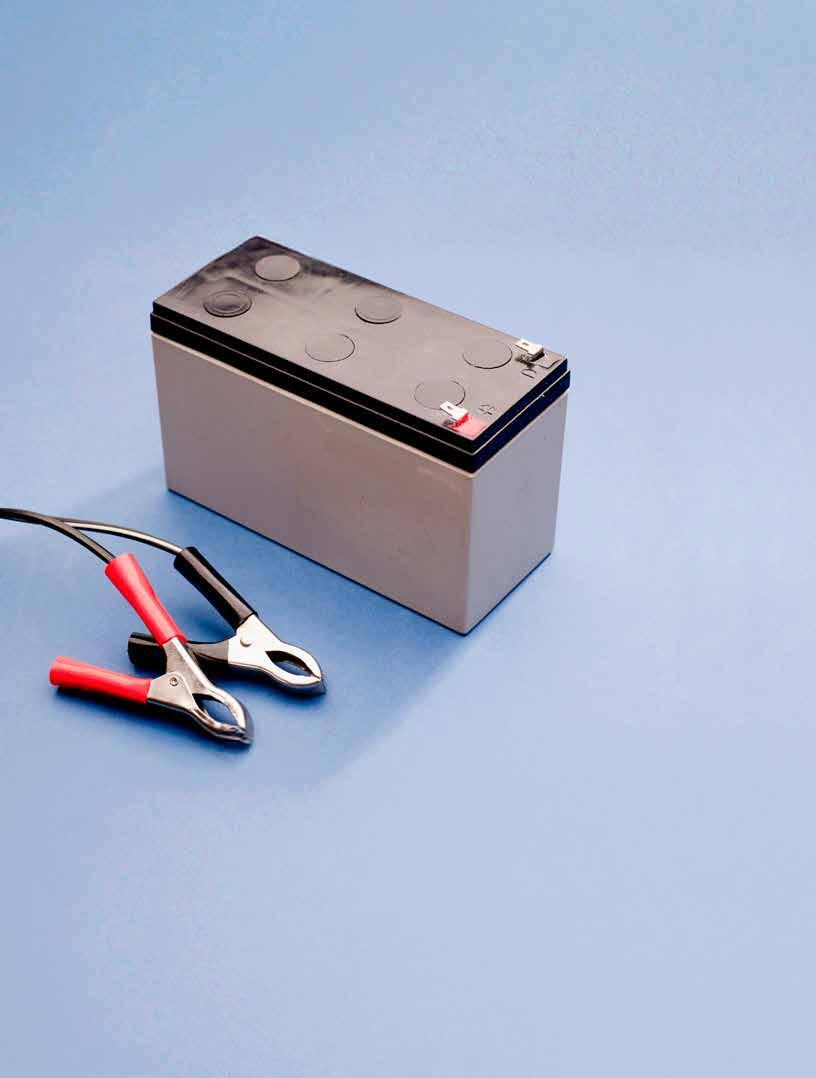

While much of the talk around batteries in the world of electric vehicles has centred around lithium-ion, a proven tested technology looks to be the key to unlocking the full potential of EVs.
Indeed, a more traditional technology continues to play a critical role in keeping these high-powered vehicles going:
The 12-volt lead-acid battery.
Automotive repair experts will note that it’s commonly forgotten that an EV still has a 12-volt battery helping power the vehicle. The vehicle’s sophisticated network of auxiliary systems depends on the humble lead-acid battery to manage everything from security features to critical safety functions. These unsung battery heroes silently ensure that when the vehicle owner approaches their EV that their key fob works, the security system activates and the vehicle's fundamental electronic systems remain operational.
Bryce Gregory, director of strategic product technology at EnerSys, offers a glimpse into this technological ecosystem. With over a decade of experience in energy storage systems, Gregory explains that the 12-volt battery

isn't just a holdover from traditional automotive design — it's a deliberately engineered solution that continues to be essential in our increasingly electrified automotive landscape.
As EVs move more into the mainstream transportation consciousness, understanding these intricate technological dependencies becomes crucial. The story of the 12-volt battery in electric vehicles is less about replacement and more about intelligent integration — a testament to the enduring power of proven technological solutions.
EVW: 12 volt lead acid batteries are taking on an important growing role as we´re vehicle electrification. Can you explain the role of these batteries in the EV market?
BG: The biggest place that I see them used today in the EV space is providing key off-type power on a typical car. You would recognize that as the ability to lock and unlock your doors or have a security system through your key fob. And, frankly, those systems are still basically built in 12-volt architectures today and for pretty much every vehicle on
``But making that battery last as long as the application and preventing the remanufacture or manufacture of multiple other products, I see those as great opportunities to be very environmentally friendly. ˝
the planet.
And in those 12-volt applications, those are critical to starting the vehicle. In EV applications in particular, charging a 12-volt battery is actually kind of complicated, because you don't have an alternator spinning every time the vehicle starts up.
EVW: What kind of challenges does that present for our industry and making this technology more convenient for consumers?
BG: I don't see a lot of changes in that space because of all the components that are developed — because of the reliability of those components, and, frankly, the low power demand of those. One of the challenges you see in that space, though, is that traditional automotive batteries — a lot of them — aren't really designed to cycle in that manner, to be able to get drawn down and then recharge. In most lead acid battery chemistries, you find in cars today, you run into them and they're dead, a lot of times, because they've sat for too long or there's some sort of parasitic drain
And there are batteries out there that are really designed well to handle that application, but they're not typically designed well to go in a car, to be able to handle the shock and vibration and all the other things associated with it.
This application in the industry is called auxiliary batteries. We'll call them low-power cycling-type applications. And improving automotive grade batteries to be able to handle auxiliary applications is really what's happening in the automotive space. You see it not just in electric vehicles but in hybrid vehicles, especially the Toyota Venza — that has a group 47 auxiliary battery that doesn't crank the engine over, but it does all these other applications and does it well and reliably. But that's a really big battery for doing those little bit of things that it does do and do well.
So you see the downsizing of that battery and improvement of the electrochemistry and its ability to handle shotgun vibration is what's happening in the lead space today.
EVW: How do these improvements help or influence the growth of the EV market?
BG
: Certainly, as the EV market grows, that's one thing that — if you look at any sort of news where people complain about EVs — that's one of the things that people complain about. “Oh, my battery died and I couldn't do anything. I couldn't open the door, I couldn't do all these things.” So that is certainly sort of a roadblock in this space to the average consumer — that they can't do the things that they would historically be able to do when they have the same kind of problems that they might normally have had.
So getting rid of those roadblocks to be able to improve the technology to make sure it works through those applications will certainly open doors for the EV market.
EVW: How do we get rid of those roadblocks? How do we move them out of our way so that it´s easier to work with?
BG: Well, certainly picking the right electric chemistry, the right design of battery for the application. I work for Odyssey Battery, and it's a battery that's AGM technology, but it also has additional advances. One of those additional advances is that it uses a pure lead architecture, meaning we don't add calcium to the grids to be able to make the battery. And when those are used, typically, it's made to make the grid stronger. And what we do is we engineer the battery with compression so the case actually provides that strength.
``The motive power battery in the vehicle needs to be a separate system to make sure that when something fails in that system, the vehicle can be safely brought to a stop. ˝

By not using calcium or antimony in the structure of the battery, we're able to avoid sulfation oxidation of the battery, and oxidation of the battery. So not that those things don't happen still, but they happen to such a lesser degree that you're able to discharge that battery lower, and it's able to recover better.
But technologies like that, that's not the only one. There are many technologies that can improve the cycle life of the battery and its ability to withstand not being fully charged for a longer period of time or surviving at a lower discharge level, which is what's happening in this application with EVs. And the batteries that are being bought off the shelf and put in a lot of these cars today just aren't really designed for it.
So picking architectures like what we do with Odyssey battery and what other companies are currently in development on will help improve their abilities to be able to handle those applications.
EVW: Why continue to use lead and these 12 volt systems?
BG: One of the big reasons that you stick with lead in addition to — these sound like simple things but there's a whole bunch of other — we'll call it, 12-volt systems in a vehicle that are important to the safety of the vehicle. Teslas have automation on them — they’re able to basically drive themselves. When you have automation on a vehicle, you have to be able to essentially operate safely, stop safely. And, frankly, the steering systems and the braking systems on these vehicles need to have backup energy. That really can't be the primary energy storage. The motive power battery in the vehicle needs to be a separate system to make sure that when something fails in that system, the vehicle can be safely brought to a stop.
And that's one of the reasons that lead is selected in those applications, predominantly in the world, is that people, engineers, companies, service providers, etc, understand that what lead batteries basically do, at least to enough of a point where they can service them and they can replace them easily, and you're not waiting days, weeks, months for replacement part, etc.
So there's a host of reasons why lead batteries are still used in these electric vehicles, and why 12-volt systems are still used in these vehicles. And that's really to support not only the simple, basic low power stuff, but also these critical safety systems.
EVW: How do you see this traditional 12 volt lead acid battery system evolve alongside the lithium ion systems that we´re seeing more and more of nowadays?
BG: That's a really good question. And frankly, I think there's a lot of companies out there trying to figure out what that means. In that market space, you have two different sides to that argument. You have the part suppliers and, typically, they try to work in concert to bring the best solutions. The other issue that you see today is the actual availability and not only the cost of using a lithium battery to replace it, but the weaknesses of that system.
So some of the weaknesses of traditional lithium systems, or it might not be so traditional but they don't really function well in cold. So if you have a lithium battery in a vehicle to support these systems, you might have to heat that battery. You might have to do some other things that actually require you to use energy that you wouldn't necessarily need in another chemistry. As well, the supply chains for lithium batteries are stressed and will be stressed for quite
a long time. The additional mining of minerals and required elements for lithium batteries, those supply chains are — with the move to EVs and hybrid vehicles — are really consuming a tremendous amount of those resources.
So not only is there supply chain constraints that will keep lead in play for a very long period of time in these applications on vehicles, both EV and non-EV, but I don't see a future where — we'll call it other lithium technology or lithium-like technologies — will likely replace lead acid batteries.
EVW: Can we develop lithium to provide the benefits we see from lead acid?
BG: Those take a long time to develop. There are things in queue today that have gone through the university levels or the corporate levels and have been proved out that they can do these things. But now you have to be able to manufacture them. You have to build a supply chain for them. And you may or may not be aware, but lithium batteries go through basically a full evolution every 18 months. So it's really hard for manufacturing to keep up with the changes in the technology. So there are a lot of things happening in that space, because it's a rapidly growing market, as well as the advent of similar technologies like sodium batteries.
So the stability of lead, and the availability of lead — and not only those things, but also the nearly 100% recyclability of lead — are an important factor in these markets and in the replacement markets in the use of the product and the lifecycle cost of those products. I don't see 12-volt architectures dramatically dropping off in the next decade. There are going to be companies that test the waters. Tesla is already, currently testing the waters with a 48-volt system on the Cyber Truck — but that truck does have a 12-volt system. Granted, it's not battery supported, or at least as far as I'm aware. So it's not that it's impossible, but there are challenges to it — and those challenges are things that people definitely don't necessarily want to deal with.
And then add to it the supply chain concerns. One of the big things about lithium batteries is there are ‘forever plastics’ in them. It's in the electrolyte; it's in other parts of the products and not easy to get rid of. And frankly, in lead batteries, you can build lead batteries without those ingredients. Today, many companies do so. There's a strong concern globally for what’s called PFAS. These are a really significant concern with the current state of lithium technology today.
So I do see a future where likely lead and also likely lithium batteries aren't really used that much. Where other technologies that will be developed in the near future, or are currently are in the beginnings of the development cycle, may replace those technologies significantly when they also meet the needs of the wide temperature range and the safety related aspects, as well as the reliability related aspects.
EVW: So these technologies will complement each other rather than compete to be the outright only choice?
BG: I would say they're complementary, especially in the EV space, and especially in things that need a whole lot of energy and need a whole lot of cyclability. Lithium has some advantages, but in applications that don't need that much and maybe need a little lower price plate product but carries a strong reliability that will work together with those technologies to make vehicles work — and work well — for the foreseeable future.
EVW: Where can lead perform better and help fill the void that lithium can´t?
BG: Well, cold climate is one. But as you're aware, most companies don't


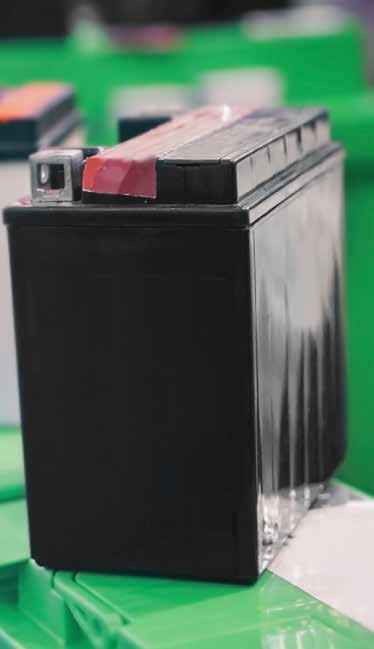
build products for distinct environments. Like in the United States alone, if you sell a vehicle — and we'll call it a commercial truck just to make it real simple — that truck could be operating in Arizona one day or one week and it could be operating in Alaska the next. So it's very difficult to segregate products in such a way based on the climate.
So having products that work in all the climates that the trucks will see, or are likely to see, is what you're going to see on vehicles, I think, for quite a while — until some new technology that surpasses and doesn't share the weaknesses of any of the products that are on the market today, comes into play.
EVW: What innovations do you see in the 12 volt battery space that could further enhance their roles in the EV market?
BG
: Certainly building, taking what we learned in lithium batteries and applying it to lead acid batteries — in terms of battery management systems and things like that — is one way that these products will improve over time. Take that technology that's been developed for other chemistries, but applying it to lead to improve it. And one of those ways is to improve how batteries charge. Just the charge rate and the exact way a battery is charged — in terms of what voltage is applied where, how much current is applied where — can have a dramatic effect on the life of that battery.
And certainly, you know recycling is great. Being able to recycle a battery at near-100 per cent type numbers is a great thing. But making that battery last as long as the application and preventing the remanufacture or manufacture of multiple other products, I see those as great opportunities to be very environmentally friendly. And that exists within the lead space today and is improving on an annual basis. You see batteries that can last longer, that use more recycled material.
And then add to that, other technologies, like some different separators, different carbon additives — simple, elemental, basic stuff that you can add to the batteries — that make them perform in partial state of charge, conditions, as well as all the different cycling and temperature, shock and vibe instances that we see. I see those things all being a benefit to the technology roadmap and to meet these future demands that we see in this space.
``So there´s a host of reasons why lead batteries are still used in these electric vehicles, and why 12−volt systems are still used in in in these vehicles.˝
Bryce Gregory, director of strategic product technology at EnerSys

Ispent four days in Vancouver this spring behind the wheel of a 2023 Polestar 2, and I came away with one clear thought: This is what an electric vehicle should feel like.
I rented the car through Turo — my second time using the platform — and the experience was seamless. The host met me at Vancouver International Airport, gave me a quick run thorough and tutorial of the car and handed over the keys. I dropped it off at the same spot four days later, fully charged and with a new appreciation for what a thoughtfully designed EV can offer.
This wasn’t my first time driving electric. I've test driven several. I’d previously rented a Tesla Model Y for a road trip from Toronto to a conference in Detroit. That was detailed in the pages of the Summer
2024 issue of this magazine.
But that was a different kind of test, with long-distance driving to experience extended highway time behind the wheel of an EV. This time, I wanted to see how an EV performed in a more everyday setting: City streets, highway hops and the occasional rural detour.
From the moment I got the Polestar 2, it gave off a different vibe. I’ve seen them on the road before so I was familiar with the look from the outside. It stands out as most EVs do but not in a way that goes too far like some. It felt modern and grounded — like a car designed for today, not a concept from tomorrow. That first impression carried through to the driving experience.
The vehicle felt solid, smooth and intuitive. It handled just as

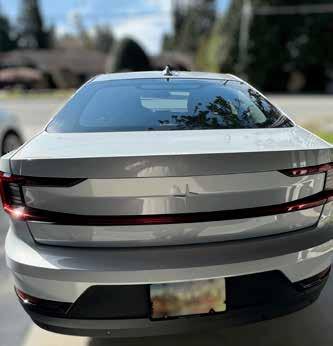
˝But this time, I wanted to see how an EV performed in a more everyday setting: City streets, highway hops and the occasional rural detour.˝

you’d want in both city traffic and on the open road. Of course, EVs are a different beast when you’re behind the wheel with the quicker acceleration and the regenerative braking, which does take some time to get used to. Doesn’t matter if you’re in a Polestar or a Tesla, these are similar experiences.
Inside, however, is where things deviate between the two brands. The infotainment system in the Polestar wasn’t as oversized or in-your-face as Tesla’s, which I appreciated. I found Tesla’s massive screen distracting at times — and often confusing as it’d display a notification on the screen then alert you that your eyes are off the road when you look at said notification.
In contrast, the Polestar’s layout felt more like it was designed by people who’ve been building cars for decades — because it was. Polestar is owned by Volvo, and that legacy of driver-focused design is obvious. Where Tesla often feels like a tech company that happens to make cars, Polestar feels like a car company that’s embraced tech in all the right ways. Even though they’ve only been test drives, I’ve had the same impression when driving the Ford Lighting or Volkswagen ID.4.
One of the biggest differences I noticed was in the overall user experience. Tesla’s approach often feels like it’s trying to impress you with features. Polestar’s approach, which is more in line with traditional automakers, is more subtle: “Here’s a great driving experience — and yes, we’ve added some cool stuff too.” That shift in priorities made a big difference.
Charging wasn’t an issue either. I was staying with family and they own a different EV. So with a charger at their home, I was able to charge up with them before returning the vehicle. I didn’t need to use public charging stations, but I noticed plenty of them around B.C. If I had needed one, I wouldn’t have been worried.
I was apprehensive following my Tesla experience last year. I worried that all EVs would have similar user experiences. Hence why I wanted to try an EV from a traditional automaker for more than just a test drive.
This put my mind at ease. Politics aside, it just felt like a more complete vehicle. It was less about showing off and more about delivering a great drive. And that’s what I want from a car — electric or not.
Driving an EV isn’t complicated. Once you get the hang of charging and adjust to the regenerative braking, it’s just driving — only quieter, smoother and, in many cases, more fun.

// By David Mayers
As electric vehicles become a more prominent feature of Canada’s automotive landscape, an opportunity is emerging for automotive repair garages across the country to engage in the repair and replacement of high-voltage EV batteries.
With more than 250,000 electric vehicles on Canadian roads as of 2024, according to Transport Canada — and these vehicles now being on the road well beyond warranty periods — their battery systems become one of the most critical and costly components to monitor, maintain, or replace. The lack of widespread battery repair expertise, limited manufacturer service networks and increasing demand for affordable used EVs create a significant opportunity for independent repair shops.
Let’s dive further into the challenges and economic opportunities for Canadian garages to become leaders in the maintenance and repair of high-voltage EV battery systems.
A pressing need
Canada has committed to ambitious climate goals, including a mandate that all new passenger vehicles and light trucks sold by 2035 must be zero-emission. To support this, the federal government has provided rebates (such as the iZEV program) and, along with the industry, has invested in charging infrastructure and educational programs such as those provided by Plug ‘N Drive to further EV adoption.
Although we have seen a recent slowdown due to the elimination of incentives, added tariffs and supply challenges over the past several years, ownership has surged in recent years, particularly in provinces like Quebec and British Columbia. Data from S&P Global Mobility show that plug-in vehicles (battery electric and plug-in hybrid
combined) accounted for almost 19 per cent of all new light-duty vehicle registrations in Q4 2024 and 9.7 per cent in Q1 2025. Despite the drop in volume, new EVs and PHEVs are still being added to our car parc.
As first-generation EVs age and reach the end of their warranties, the aftermarket support structure is becoming critically important. While legacy automakers like Toyota, GM, Ford and Hyundai offer battery replacement services, these are often centralized and limited to dealerships, creating delays and high costs. Many EVs are now past their warranty periods and will require battery diagnostics, repairs, or outright replacement. This presents a pressing need and a business opportunity for skilled independent garages.
The issue with EV battery replacement is that they’re expensive. A full replacement of a high-voltage lithium-ion battery can cost anywhere between $12,000-$25,000, and even more for high-end or independent manufacturers, depending on the vehicle model.
For example, a Chevrolet Bolt’s battery replacement can exceed $16,000, while a Tesla Model S will surpass $20,000. My Kia EV Soul battery cost more than $20,000. These high costs contribute to depreciation and hesitation in the used EV market. Repairing rather than replacing batteries can offer consumers a more affordable path to keeping their vehicles on the road, especially when many manufacturers designed their batteries to be serviced and or repaired.
My Kia battery had its internal battery modules replaced as opposed to a new battery pack and my vehicle’s performance is as it was when new, with full range.
There are opportunities for Canadian shops that invest in battery diagnostic and repair capabilities to offer repair services such as:
■ Module-level diagnostics and replacement: Individual cells or modules may degrade at different rates. Replacing faulty modules is far cheaper than full pack replacements.
■ Thermal management system repairs: EVs use complex liquid or air-based systems to keep battery temperatures optimal. Failures here can be repaired independently of the battery core in some batteries.
■ Battery management system recalibration: Software and sensor
issues can mimic battery degradation and may be resolved through reprogramming.
■ Battery pack resealing and maintenance: Especially in salt-heavy environments like Ontario and Quebec, corrosion and water ingress can damage battery housings.
The cost advantage for consumers choosing to repair instead of replace creates a market incentive. For instance, a garage that charges $4,000 for a module replacement may help the customer avoid a $20,000 full-pack replacement, while still generating a strong profit margin.
One of the biggest drivers of demand is the growing population of aging EVs. Many early adopters of Nissan Leafs, Chevrolet Volts and older Teslas are now facing battery degradation. In addition, there are also some vehicles, such as older Prius models, that can be upgraded to lithium for increased performance and range.
Natural Resources Canada reports that lithium-ion battery life varies between 8 to 15 years, depending on usage, climate and charging behaviour. In colder regions of Canada, this may be even further pronounced when degradation is coupled with colder temperatures and limited infrastructure.
Meanwhile, the centralized service models of OEMs and the shortage of trained dealership technicians create a service bottleneck. Wait times of several months for battery replacement are not uncommon. In Ontario and Alberta, for example, EV owners have reported waiting up to six months for parts and qualified technicians.
Independent shops that can offer faster service with lower costs stand to fill this vacuum. For rural and northern communities, especially where dealership access is limited, local garages could become essential service providers for EV owners.
I have often promoted safe practices and hands-on training when servicing EVs because, as we all — I hope — know now, working on high-voltage batteries is not difficult if you are prepared. But knowledge and safety are paramount.
These systems operate at voltages exceeding 400 volts, posing electrocution risks if mishandled. The lithium-ion chemistry involved can lead to other risks, such as fires and thermal runaway, if battery cells are punctured or improperly assembled. Training and equipment costs can be significant. However, with battery repairs generating thousands of dollars in revenue per job, many garages can recover these costs within their first year of operation.
According to the Canadian Apprenticeship Forum, there are fewer than 10,000 EV-trained technicians across Canada — and fewer than 1,000 with high-voltage battery training or certification. Ontario alone will require more than 20,000 EV-trained technicians by 2030, especially in growing EV markets like Toronto, Ottawa and Windsor.
Colleges and trade schools are beginning to respond. For instance, Centennial College in Toronto and BCIT in British Columbia now offer EV repair modules. However, most graduates still lack handson battery repair experience.
Some organizations have developed strong internal training programs, such as NAPA through its NexDrive program — where certified repair shops are capable of doing EV repair including battery repair.
Independent training firms such as the AutoProf and Environmental Motorworks, with which I am affiliated, also provide in-class or inhouse, hands-on diagnostic and repair training, including battery repair and replacement. This represents a further opportunity for shops to
partner with training institutions and develop in-house expertise.
A robust battery repair industry is crucial for strengthening Canada’s used EV market.
One of the top reasons Canadians hesitate to buy used EVs is battery longevity and replacement cost uncertainty. A 2023 survey by KPMG Canada found that 61 per cent of Canadians were concerned about the high cost of battery replacement in used EVs, which reduced their willingness to purchase second-hand.
Independent garages that can assess, diagnose and repair batteries affordably will help reassure used EV buyers. Services such as pre-sale battery health inspections, range reconditioning or warranty-backed battery repairs could become key selling points in the secondary market.
The opportunity for battery repair does vary by region. In Quebec, where over 54 per cent of new EVs in Canada were registered in 2024, the density of EVs makes battery repair a high-demand service. Quebec’s cold winters and salted roads also accelerate battery housing degradation —leading to more corrosion-related service needs.
In British Columbia, high EV adoption in urban areas and provincial incentives support a healthy EV ecosystem, but battery replacement still faces bottlenecks. Independent repair could flourish in cities like Victoria, Kelowna and Nanaimo, where dealership access is limited.
In Ontario, the market is fragmented, with large urban centres like Toronto showing strong demand but vast rural areas being underserved. Shops in these regions may be able to tap into EV service deserts — especially if mobile repair services are developed.
In step with this, there is growing interest in battery reconditioning and reuse. Companies like Relectrify and Voltaiq are developing second-life applications for battery packs — either for stationary energy storage or low-power vehicle use. There is a market in salvaging healthy modules from degraded packs and reselling them to energy storage providers or manufacturers.
By enabling repair over replacement, independent garages also contribute to the circular economy and meeting Canada’s environmental goals. A typical EV battery contains significant quantities of lithium, cobalt, and nickel. Repairing battery modules instead of replacing full packs reduces the demand for new raw materials.
Canada is home to emerging recycling players such as LiCycle and RecycLiCo, but the industry benefits when batteries can be kept in service longer. Independent garages can become an essential bridge between EV owners and recyclers, identifying which batteries can be repaired and which must be retired.
The repair and replacement of high-voltage EV batteries is not only a necessity in Canada’s transition to zero-emission transportation, it is a lucrative and essential opportunity for the automotive service industry.
With the right investment in training, equipment and safety protocols, independent shops across Canada can fill a growing gap in the EV ecosystem. In doing so, they can generate new revenue, support sustainable transportation, and contribute to an important used EV market.
David Mayers is chief executive officer at Environmental Motorworks, an innovative services company centred on providing hands-on EV and hybrid training to technicians and fleet operators in the automotive and heavy equipment sectors.
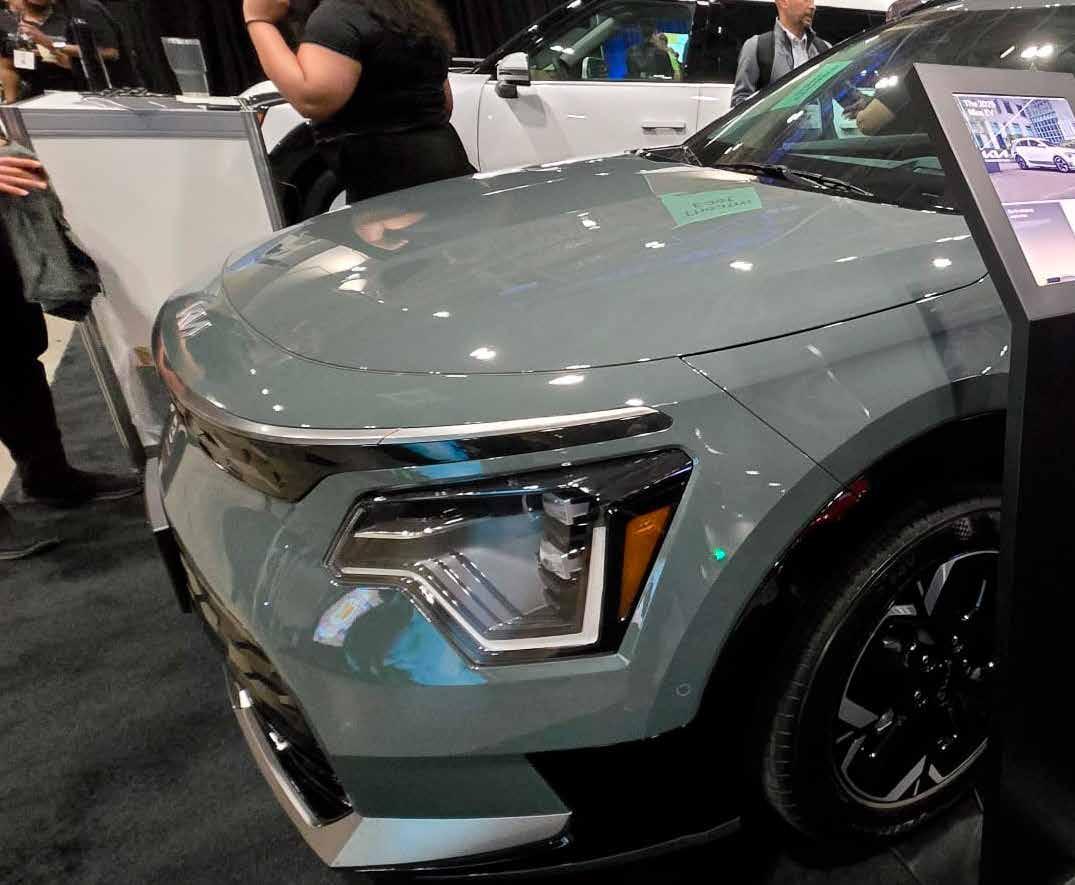
The EV Vehicle and Charging Expo was nothing short of electrifying — literally and figuratively.
If you thought the electric vehicle revolution was slowing down, think again. The pace of innovation in this space is ongoing, with charging technology and aftermarket service models evolving faster than many can keep up. This was on full display during the two-day show held in Toronto from May 14-15.
While EV charging might seem like a commoditized offering, the expo highlighted just how much nuance and differentiation still exist in this growing market.
One of the standout voices at the expo was Yves Racette of UAP/ NAPA Canada. His presentation centred around NAPA's NexDrive program — a bold initiative empowering independent shops to become EV service leaders. With 60-plus NexDrive-certified shops already operating in Canada, NAPA is quickly carving out leadership in aftermarket EV support.
But what really caught my attention was how NAPA is tackling high-voltage (HV) component service head-on. They're enabling
remanufacturing and state-of-health diagnostics on used EV components through partnerships with specialized EV salvage operations. This is a game-changer — finally, a consistent way to benchmark quality for reused batteries and HV systems, all while staying profitable and sustainable. Contrast this to salvaged ICE engines: Often, you do not know if you bought a lemon, how that vehicle was maintained prior or treated.
Racette also brought an AutoPro shop owner to the stage, Andrew Ackers owner of Upper James AutoPro in Hamilton, Ontario. His candid remarks were refreshingly honest. Once skeptical — concerned like many that EVs would reduce service work by 80 per cent — he now sees opportunity everywhere. Battery replacements, HV diagnostics, and even software-related service issues are yielding repair orders in the thousands.
And here’s the kicker: Many of his customers had quotes from OE dealers that were double what his shop charged, proving the aftermarket has not just a role in the market— but a competitive edge.
On the charging side of the expo, vendors like Swtch, Flo, Zerova, and

Chargnex all brought their A-game, each pitching their unique blend of durability, software and affordability.
However, the standout for me was Jule. Their solution blends DC fast charging with built-in battery storage, allowing the unit to trickle charge during off-peak hours. When customers plug in during peak demand times, the unit draws from internal reserves — saving everyone money. Available in 220, 440, and even 660 kWh capacities, this feels like a smart step forward in energy efficiency and cost control.
If you’re in the aftermarket and haven’t heard of Wesco, don’t feel bad — I hadn’t either. Despite racking up $20B in annual revenue and being a Fortune 200 player, they’ve flown under the radar for many of us entrenched in traditional parts and tools.
Historically rooted in the electrical and utilities sector, Wesco is now a major force in EV charging infrastructure. They distribute brands like Wallbox, Electric Avenue, Flo, and ChargePoint for both commercial and residential installs, making them a onestop shop for anyone looking to future-proof their shop or fleet.
Here’s what I walked away with as someone focused on the evolving needs of the independent garage and parts distributor:
EV training is critical: Don’t go it alone. NAPA’s HV training isn’t just for their 'NAPA' customers — it’s available agnostically. If your shop wants to play in this space, this is the low-hanging fruit.
Retrofit charging is the next “top up” service: Think of charging like oil top-ups. If you’re servicing EVs, offering customers a partial charge before they leave your shop will soon become an expected convenience.
Distributors need to think like equipment dealers: Charging stations are the new alignment machines. Use partners like Wesco to drop-ship units directly to customers. No need to inventory—just connect the dots and offer solutions.
The expo didn’t just focus on charging and repair — it also dove into fleet management. A company called Samsara demonstrated an AI-powered tracking system that monitors driver behaviour using facial recognition. Think distracted driving, no seatbelt, mobile phone usage, and even drowsiness— tracked in real-time. The result? Not just safer roads, but potentially lower insurance premiums and fewer liabilities for fleet operators.
The bottom line? The aftermarket isn’t being left behind by the EV movement — it’s being reinvented by it. From training and service to infrastructure and safety, the future is not only bright — it’s fully charged.
Derek Suen, MBA, is an automotive aftermarket professional with 15 years of experience, specializing in product research for high-demand parts. With a background in both manufacturing and distribution, he brings deep insight into customer needs across North American and European markets.
Stats that put the North American automotive aftermarket into perspective
Most EV owners prefer going to the dealership for any maintenance and repair needs — 73% believe dealer techs are better trained than those at independent shops.

The majority of EV owners say they’ll buy another with 70% saying their EV is the best vehicle they’ve ever owned.
Battery electric vehicle sales make up almost one in five new vehicle registrations in December 2024. That number dropped to about 10% in January 2025.
S&P Global Mobility
AIA Canada 44 % 44%
The number of Canadians thinking about a PHEV as their next vehicle with 51% of Gen Z and 54% of Millennials saying so.
Volvo Canada
FedDev Ontario announced an investment in Project Arrow 2.0. More than 55 Canadian businesses contributed to the first Project Arrow. 54% 7 MILLION 17.8% 82% 20% 20% 82%
One in five Canadian auto shoppers consider themselves “EV ready,” while 50 per cent are “EV curious.” One in three identified as “EV skeptic.”

The number of current vehicle owners now driving some form of electric or hybrid car, including traditional hybrids, fully electric vehicles and plug-in hybrids.
Volvo Canada

The desire to cut expenses — such as fuel costs — is the most significant factor for Canadians aged 18 to 34 in choosing a PHEV.
Volvo Canada
An overwhelming majority of current BEV owners said they would stick with a BEV for their next vehicle purchase.
J.D. Power
EV & Charging Expo
May 14-15, 2025
Toronto, Ontario
The EV & Charging Expo showcased many opportunities in the electric vehicle world, from infrastructure to financial to idea sharing, but also focused on the aftermarket. Attendees were able to take in sessions geared to the aftermarket sector, learning how independent shops are becoming service leaders. Battery replacements, high voltage diagnostics and even software-related service issues are yielding lucrative repair orders for an industry still finding its footing in the relatively new space.




